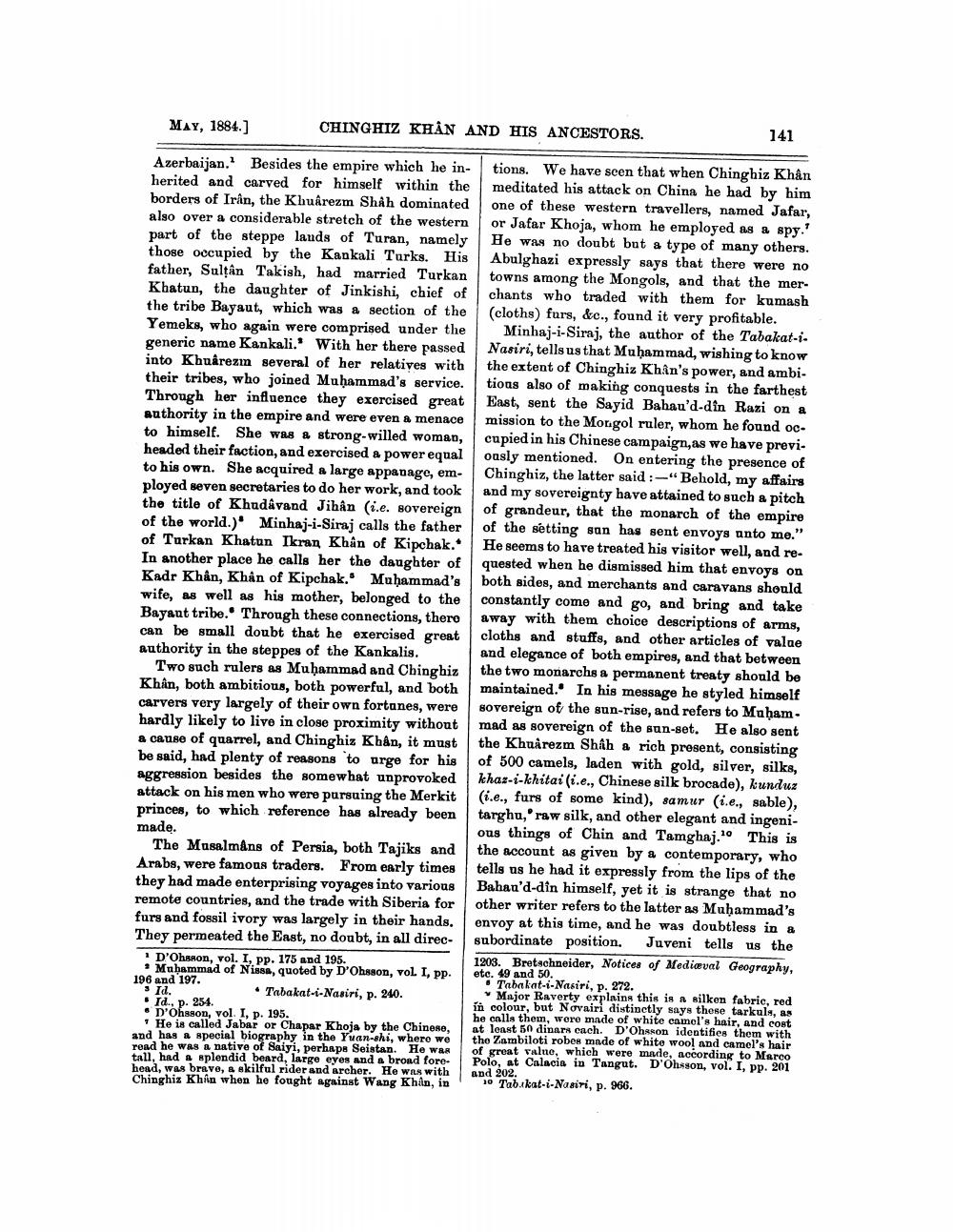________________
CHINGHIZ KHAN AND HIS ANCESTORS.
MAY, 1884.]
Azerbaijan. Besides the empire which he inherited and carved for himself within the borders of Irån, the Khuârezm Shah dominated also over a considerable stretch of the western part of the steppe lauds of Turan, namely those occupied by the Kankali Turks. His father, Sulțân Takish, had married Turkan Khatun, the daughter of Jinkishi, chief of the tribe Bayaut, which was a section of the Yemeks, who again were comprised under the generic name Kankali." With her there passed into Khuârezm several of her relatives with their tribes, who joined Muḥammad's service. Through her influence they exercised great authority in the empire and were even a menace to himself. She was a strong-willed woman, headed their faction, and exercised a power equal to his own. She acquired a large appanage, employed seven secretaries to do her work, and took the title of Khudâvand Jihân (i.e. sovereign of the world.) Minhaj-i-Siraj calls the father of Turkan Khatun Ikran Khân of Kipchak. In another place he calls her the daughter of Kadr Khan, Khân of Kipchak. Muhammad's wife, as well as his mother, belonged to the Bayant tribe. Through these connections, there can be small doubt that he exercised great authority in the steppes of the Kankalis.
Two such rulers as Muḥammad and Chinghiz Khân, both ambitious, both powerful, and both carvers very largely of their own fortunes, were hardly likely to live in close proximity without a cause of quarrel, and Chinghiz Khân, it must be said, had plenty of reasons to urge for his aggression besides the somewhat unprovoked attack on his men who were pursuing the Merkit princes, to which reference has already been made.
The Musalmans of Persia, both Tajiks and Arabs, were famous traders. From early times they had made enterprising voyages into various remote countries, and the trade with Siberia for furs and fossil ivory was largely in their hands. They permeated the East, no doubt, in all direc
D'Ohsson, vol. I, pp. 175 and 195.
Muhammad of Nissa, quoted by D'Ohsson, vol. I, pp. 196 and 197. Id. Id., p. 254. D'Ohsson, vol. I, p. 195.
Tabakat-i-Nasiri, p. 240.
He is called Jabar or Chapar Khoja by the Chinese, and has a special biography in the Yuan-shi, where we read he was a native of Saiyi, perhaps Seistan. He was tall, had a splendid beard, large eyes and a broad forehead, was brave, a skilful rider and archer. He was with Chinghiz Khan when he fought against Wang Khân, in
141
tions. We have seen that when Chinghiz Khân meditated his attack on China he had by him one of these western travellers, named Jafar, or Jafar Khoja, whom he employed as a spy." He was no doubt but a type of many others. Abulghazi expressly says that there were no towns among the Mongols, and that the merchants who traded with them for kumash (cloths) furs, &c., found it very profitable.
Minhaj-i-Siraj, the author of the Tabakat-iNasiri, tells us that Muhammad, wishing to know the extent of Chinghiz Khân's power, and ambitions also of making conquests in the farthest East, sent the Sayid Bahau'd-din Razi on a mission to the Mongol ruler, whom he found occupied in his Chinese campaign, as we have previ ously mentioned. On entering the presence of Chinghiz, the latter said :-"Behold, my affairs and my sovereignty have attained to such a pitch of grandeur, that the monarch of the empire of the setting sun has sent envoys unto me." He seems to have treated his visitor well, and requested when he dismissed him that envoys on both sides, and merchants and caravans should constantly come and go, and bring and take away with them choice descriptions of arms, cloths and stuffs, and other articles of value and elegance of both empires, and that between the two monarchs a permanent treaty should be maintained. In his message he styled himself sovereign of the sun-rise, and refers to Muḥammad as sovereign of the sun-set. He also sent the Khuȧrezm Shâh a rich present, consisting of 500 camels, laden with gold, silver, silks, khaz-i-khitai (i.e., Chinese silk brocade), kunduz (i.e., furs of some kind), samur (ie., sable), targhu, raw silk, and other elegant and ingenious things of Chin and Tamghaj.10 This is the account as given by a contemporary, who tells us he had it expressly from the lips of the Bahan'd-din himself, yet it is strange that no other writer refers to the latter as Muhammad's envoy at this time, and he was doubtless in a subordinate position. Juveni tells us the 1203. Bretschneider, Notices of Medieval Geography,
etc. 49 and 50.
Tabakat-i-Nasiri, p. 272.
Major Raverty explains this is a silken fabric, red in colour, but Novairi distinctly says these tarkuls, as he calls them, were made of white camel's hair, and cost at least 50 dinars each. D'Ohsson identifies them with the Zambiloti robes made of white wool and camel's hair of great value, which were made, according to Marco Polo, at Calacia in Tangut. D'Ohsson, vol. I, pp. 201
and 202.
10 Tabakat-i-Nasiri, p. 966.




